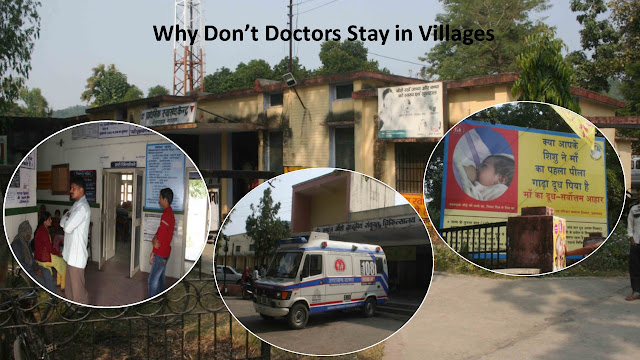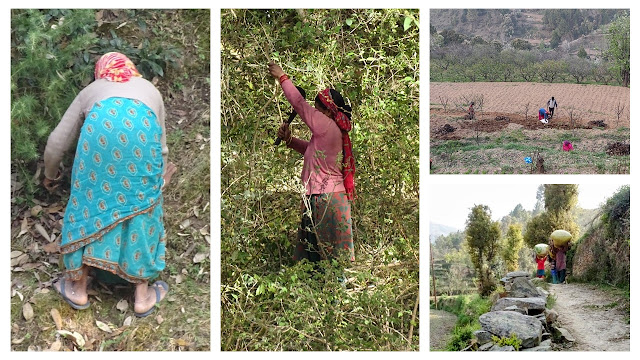An evening well spent
Yesterday evening I decided to take different route for my evening walk. I walked down a precipitous path deep into what is called a gadhera or gardh where a seasonal stream gurgles happily this time of the year. The landscape here is very different. Its quieter, the fields are broader and usually they are more lush because they are irrigated. I loved the multi-cropping on the fields. They were mostly filled with patta-gobhi ( cabbage) or maize. Some fields also had rajma or kidney beans and the local black soya bean which is known as bhat. There were some amaranth with their red flowing locks, vines of lauki (gourd) and kakri (cucumber) interspersed with some small stands of cannabis. A paste made of roasted cannabis seeds is used as a local spice or condiment. When we worked in these hills nearly 3 decades ago, we had also learnt that the cannabis stalks provided an excellent hemp like fibre as well. It was used to make ropes, sacking and also used it to make soles for their footwear.
As I walked along the fields with the small river keeping me company I chatted with the women and men working in the fields. Most knew who I was but one old lady whose house was directly under ours didn’t know, so I pointed to our house up against the sky and she shook her head in acknowledgement.
The one grain I was looking for and missed was madua, or finger
millet, which was grown widely earlier. Only one of the households had a very
small patch which I had missed because it didn’t yet have its distinctive stalks
shaped like upturned or curled fingers. ‘It’s very hard work’ they said. ‘The
patta-gobi has driven the madua away’, said another.
I have a soft spot for madua because many moons ago I had
conducted my first formal study on this tiny grain. Illiterate women had taught
me how to identify varieties by the shape, size, and colour of the grains. They
knew which variety to grow on which aspect and slope of their fields based on
the micro-habitat. They had informal mechanisms to share seeds to maintain the germplasm.
It was my very first academic paper which I presented at my first visit to
India International Centre in Delhi. Later, I was invited to present this study
at an international conference at Harare, (Zimbabwe) in what would have been my
first trip abroad. Unfortunately, the trip was aborted, and I have yet to visit
the city. My interest around women’s role in agriculture was soon derailed. But I digress.
Growing madua is back breaking work, but it was also an occasion
for common celebrations. When the seed was sown or the grain harvested, it had
to be done all at once. The villagers had a ‘palta’ or give and take system and
neighbouring women would work in each other’s fields while a man would be
invited to sing and play the ‘hudka’ (a small drum). In between were rounds of
weeding, and all of it would be done by women. Today all the fields that would have
madua are occupied by cabbage. Madua is a coarse grain and the flour lacks finesse.
The thicker harder madua ki roti has lost to the finer ‘phulka’ made gehu (wheat)
atta. The replacement crop cabbage also brings in the much needed moolah as it
is a cash crop.
Like many others I hold that organic farming is superior to modern
farming. But at the same time, I am conflicted. I know that the ‘green
revolution’ with its attendant ills was essential to making India a food
sufficient country. Having dabbled in traditional agriculture I had learnt how
modern mechanised agriculture had alienated women from the land and their vast
knowledge of traditional agriculture. Madua ka atta is no longer available in
the village homes but is becoming popular in supermarkets of Delhi and other big
cities. I wondered whether madua could be grown as a cash crop here. But wouldn’t
that make women’s workload even harder? Can poor people afford to eat the food
that they grow?
With these thoughts going through my head, I started climbing
up the hill through a patch of oak forest. When I reached the road, two children,
a girl of about 8 years and boys couple of years younger greeted me, big smiles
on their faces. I asked them their names and they told me they were Tannu and
Bittu. Pointing towards a big sack of atta lying a few feet away she asked me ‘Will
you lift it and put it here?’. It was a sack of atta which a jeep had brought
from the market up the road and dropped off a few feet into the road. She
wanted me to lift it and bring it to the side. I tried lifting it – it was heavy,
and I didn’t want to risk my back. ‘I can’t lift it’, I said. ‘No problem, let
me help you’, said this little three foot something thin as stick girl. She reached
out to lift one end and asked me to lift the other end. Taken aback at her
alacrity, I said ‘Wait, let me roll it over’. Girding my loins, I shifted my weight
and gave a heave to roll the sack. With two rolls the sack was off the metalled
surface, and she was happy. ‘Do you know who I am?’ I asked surprised at her confidence.
‘Uncle’, she said, ‘you live in the house near the school’. Bidding the brother
and sister goodbye, I started walking back home.
It was an evening well spent!





As the saying goes," Change is the only permanent thing in this world"...For good or for worse? We'll never know... but sad nonetheless.
ReplyDeletenice story and realistic depiction sadly ...and this is what makes your area in kasialekh different from almora district, including some of our old working areas like Tola....they never gave up on traditional crops, mixed cropping and rotational cropping system
ReplyDeleteIn mukteshwar area, mandua is hardly seen and generally women get them from.their maika ...one of the young girls I met few years ago asked her mother, around the same time of the year...how is mandua grown...while this is not the situation in almora and far away areas
I am happy that a more sustainable ecosystem based living continues in these hills. It's so encouraging.
DeleteIt does..especially in far off areas , areas of almora, pithoragarh, bageshwer, champawat districts in kumaon region. And scenario regarding workload, womens work, access and control, market dependence, organic market , is layered..with no simple..yes and no..
ReplyDeleteGood story. More expected
ReplyDeleteThanks. And will.
DeleteNice read. But many things are still a mystery for us not born on the subcontinent.
ReplyDeleteLiked the warmth of the story! The story around Madua too gave a picture of the changes that have come about in our countryside. I suppose, one more aspect of the change is the number of young people who have actually left farming - leaving farming to be done by the older generation. In Uttarakhand, my understanding is that many farms as lying fallow and abandoned.
ReplyDelete